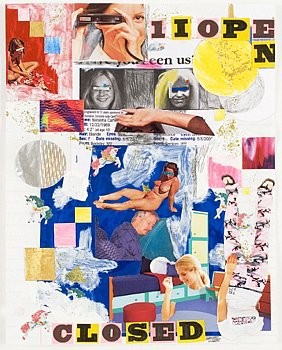Collage
12 Nov 2007 - 26 Jan 2008
COLLAGE
Gagosian Gallery is pleased to announce an exhibition of recent collage, by more than fifty artists, many of whom have created works specifically for this occasion. Fit to Print exposes the artist's compulsion to react to the steady stream of information that the print media delivers on a daily basis. The works on view range from meditations on formal composition to personal perspectives on current events.
All works included in this exhibition have been made since January 2000, illuminating the vast extent to which contemporary international artists share an interest in the myriad forms of printed media while working within the traditional definition of collage. A thoroughly modernist invention, the use of collage first appeared in the work of Picasso and Braque and was embraced by the international Dada movement as a mode of political critique. Whether referring to autobiography, disposable pop culture, or actualities of global politics, the artists in this exhibition acknowledge the legacy of past practice by immediately utilizing mass-distributed, readymade print, and incorporating it directly into their work.
Picasso's ability to unite formal and political concerns on the eve of World War I resonates in today's moment of global turmoil, and is acknowledged at the onset of the exhibition by the inclusion of a single, rare Picasso, Bottle and Glass, autumn-winter 1912. As one of the first examples of collage ever made, Picasso's simple yet radical gesture of incorporating primary physical objects rather than painted representations continues to inspire.
Today, images of vilified political figures, juxtaposed with provocative text fragments, critique contemporary events in real-time and evoke the structures engineered by Hannah Hoch and her contemporaries.
Collage has also embraced a pop aesthetic of advertising and consumer desire, a technique pioneered by Richard Hamilton in the mid 1950s. More recently, the heightened presence of tabloids has inspired the repetition and mutation of international gossip-fixtures and instantly recognizable icons, drawing attention to an increasingly ubiquitous fascination with celebrity. Other incantations of fantasy and fame include the tawdry, marginalized decadence of pornography and pop music, specifically rock n' roll, hip-hop and punk.
These fractured planes foster a sense of dislocation and employ the established strategies of cut and paste in the tradition of Picasso as the means of establishing formal and psychological investigations of space. Oscillating between abstraction and figuration, these works dismantle the present in order to reflect a society captivated by the media.
Gagosian Gallery is pleased to announce an exhibition of recent collage, by more than fifty artists, many of whom have created works specifically for this occasion. Fit to Print exposes the artist's compulsion to react to the steady stream of information that the print media delivers on a daily basis. The works on view range from meditations on formal composition to personal perspectives on current events.
All works included in this exhibition have been made since January 2000, illuminating the vast extent to which contemporary international artists share an interest in the myriad forms of printed media while working within the traditional definition of collage. A thoroughly modernist invention, the use of collage first appeared in the work of Picasso and Braque and was embraced by the international Dada movement as a mode of political critique. Whether referring to autobiography, disposable pop culture, or actualities of global politics, the artists in this exhibition acknowledge the legacy of past practice by immediately utilizing mass-distributed, readymade print, and incorporating it directly into their work.
Picasso's ability to unite formal and political concerns on the eve of World War I resonates in today's moment of global turmoil, and is acknowledged at the onset of the exhibition by the inclusion of a single, rare Picasso, Bottle and Glass, autumn-winter 1912. As one of the first examples of collage ever made, Picasso's simple yet radical gesture of incorporating primary physical objects rather than painted representations continues to inspire.
Today, images of vilified political figures, juxtaposed with provocative text fragments, critique contemporary events in real-time and evoke the structures engineered by Hannah Hoch and her contemporaries.
Collage has also embraced a pop aesthetic of advertising and consumer desire, a technique pioneered by Richard Hamilton in the mid 1950s. More recently, the heightened presence of tabloids has inspired the repetition and mutation of international gossip-fixtures and instantly recognizable icons, drawing attention to an increasingly ubiquitous fascination with celebrity. Other incantations of fantasy and fame include the tawdry, marginalized decadence of pornography and pop music, specifically rock n' roll, hip-hop and punk.
These fractured planes foster a sense of dislocation and employ the established strategies of cut and paste in the tradition of Picasso as the means of establishing formal and psychological investigations of space. Oscillating between abstraction and figuration, these works dismantle the present in order to reflect a society captivated by the media.

